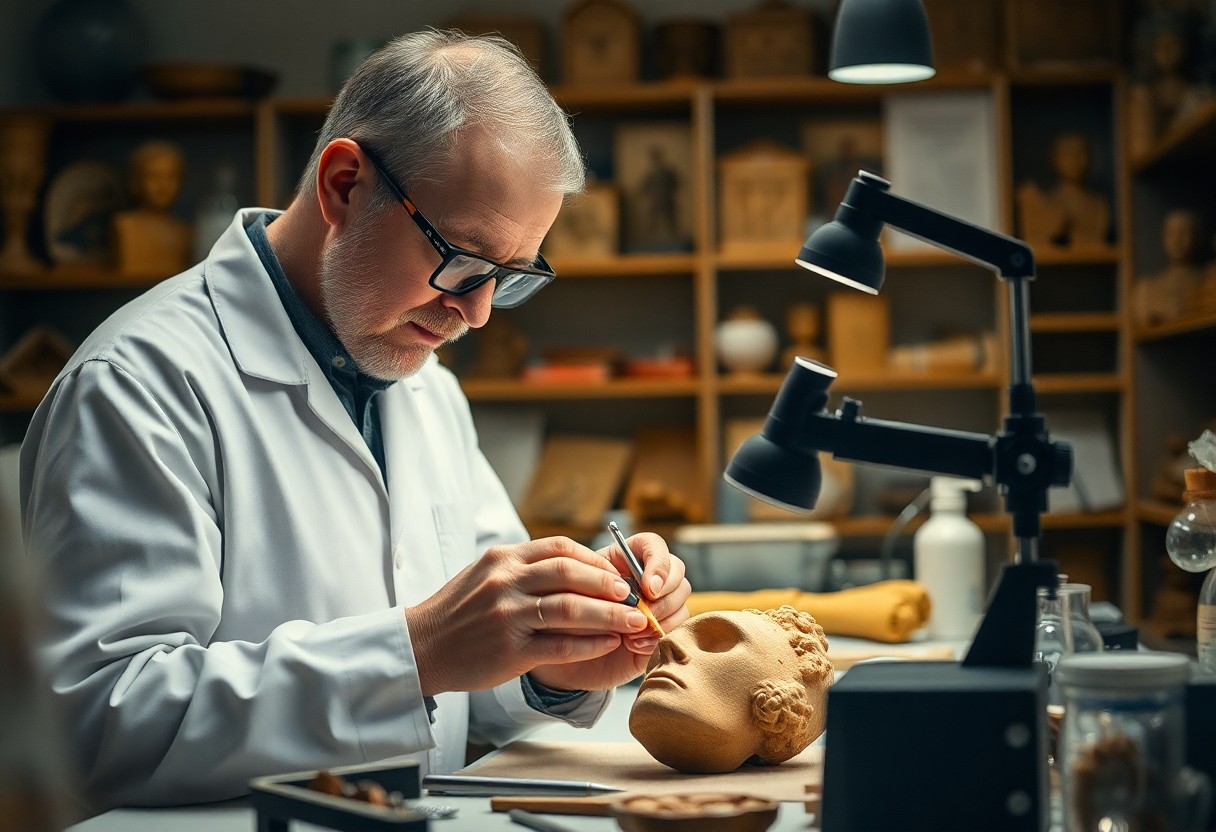Conservation of cultural heritage is an imperative pursuit that allows you to preserve, protect, and restore artifacts for future generations. By enrolling in the Master of Cultural Material Conservation (MCMC) program, you will develop specialized skills and knowledge in object handling, materials science, and conservation ethics. This advanced degree prepares you to tackle the challenges artisans face in maintaining and interpreting artifacts, ensuring that the history and significance of cultural objects remain intact. Discover how this program can enhance your professional journey and contribute to the vital field of cultural preservation.

Key Takeaways:
- The Master of Cultural Material Conservation (MCMC) program focuses on equipping students with the skills to preserve and restore cultural heritage artifacts.
- Students engage in hands-on training and learning, often collaborating with museums and conservation labs to apply their knowledge in real-world settings.
- The program emphasizes interdisciplinary approaches, including art history, science, and ethics, to ensure a comprehensive understanding of cultural preservation.
Overview of the MCMC Program
The Master of Cultural Material Conservation (MCMC) program equips you with the skills and knowledge necessary to preserve and protect cultural heritage items. Through a blend of theoretical learning and practical application, you’ll dive deep into the principles of conservation, ethical considerations, and new technologies in the field. This comprehensive program not only fosters your understanding of material science but also encourages a holistic approach to preserving artifacts for future generations.
Program Goals and Objectives
Against the backdrop of an ever-evolving cultural landscape, the MCMC program aims to develop your expertise in the conservation of various material types, enhancing your ability to assess, treat, and manage cultural heritage artifacts. Your learning will focus on sustainability, ethical practices, and interdisciplinary collaboration, all crucial to the preservation of our collective history.
Curriculum and Requirements
Program components include core courses, hands-on laboratory work, and field experiences designed to build your technical and analytical skills in conservation. You’ll also engage in research projects that deepen your understanding of materials, historical context, and preservation techniques.
Program coursework typically encompasses materials science, conservation ethics, and preventative conservation strategies. You will participate in workshops, seminars, and internships that immerse you in real-world scenarios. Additionally, expect to compile a portfolio showcasing your practical experiences and research findings, which will serve as a valuable asset in your professional career after graduation.
Importance of Cultural Material Conservation
Assuming you recognize the value of preserving cultural heritage, understanding the importance of cultural material conservation becomes paramount. This practice safeguards historical artifacts, ensuring that future generations can engage with and learn from their cultural roots. By conserving, you help maintain the integrity of community identities, historical narratives, and educational opportunities inherent in these materials.
Historical and Cultural Significance
The preservation of cultural materials is vital for maintaining the historical and cultural identity of communities. Each artifact tells a story, representing unique traditions, beliefs, and practices that signify a collective past. By conserving these items, you help protect the narrative of your culture, fostering a sense of belonging and continuity.
Techniques and Methods Used
On examining the techniques and methods used in cultural material conservation, you will find a blend of traditional practices and modern technology tailored to specific materials. Strategies may include cleaning, stabilization, and appropriate storage to mitigate deterioration. Each approach is designed to respect the artifact’s integrity while ensuring its longevity for educational and historical purposes.
Significance lies in the blending of techniques, such as preventive conservation, which focuses on monitoring environmental factors, alongside remedial conservation that addresses existing damage. You may encounter methods like digital documentation, which provides a comprehensive record of artifacts without physical interference, and chemical treatments to halt decay. Utilizing expert knowledge, these methods are vital for safeguarding your cultural heritage while ensuring that each artifact can be appreciated in its fullest context.

Career Opportunities for MCMC Graduates
Despite the competitive nature of the field, graduates of the Master of Cultural Material Conservation (MCMC) program can find diverse career opportunities in various sectors. With the expertise gained, you may explore roles in museums, galleries, and conservation organizations. Engaging with the community through Masters of cultural materials conservation query! : r/unimelb can provide additional insights into your career path.
Roles in Museums and Galleries
Before pursuing a career, you should consider positions within museums and galleries where your passion for preserving cultural heritage can shine. These institutions often seek professionals skilled in artifact restoration, exhibition planning, and educational outreach. This setting allows you to engage with the public while utilizing your conservation skills effectively.
Positions in Conservation Organizations
Above the traditional roles, conservation organizations present unique opportunities to impact the preservation of cultural heritage on a larger scale. You may find positions that focus on research, consultancy, and training within these organizations, facilitating best practices in conservation methods.
It is important to note that positions in conservation organizations often require you to be proactive in your professional development. Engaging with ongoing research initiatives, attending workshops, and networking with professionals in the field can elevate your career prospects. Your contributions can influence significant conservation projects that protect cultural assets for future generations, aligning your work with global preservation efforts.
Research and Innovations in Conservation
Unlike traditional methods, modern research and innovations in conservation strive to enhance the longevity and effectiveness of cultural heritage preservation. Cutting-edge technologies, interdisciplinary approaches, and novel materials are revolutionizing how conservators approach their work, ensuring that treasures from the past can be preserved for future generations. By embracing these advancements, you can better contribute to the evolving field of cultural material conservation.
Advancements in Conservation Science
Behind each innovative technique lies a wealth of scientific research that informs best practices in conservation. Advances such as non-invasive imaging, automated monitoring systems, and sustainable materials are helping you achieve more effective conservation outcomes. These scientific breakthroughs equip you with the tools to analyze, monitor, and restore artifacts with greater precision.
Case Studies and Successful Projects
Successful conservation initiatives demonstrate the impact of research-driven practices. Engaging with these case studies can inspire you and provide valuable insights into effective strategies for preserving cultural materials. Consider the following projects where significant improvements were achieved:
- The restoration of a 16th-century painting in Florence increased its visibility and stability, resulting in a 50% decrease in deterioration rates.
- A collaborative project at the Museum of Modern Art utilized advanced imaging techniques, enhancing art conservation treatment results by 40%.
- The implementation of climate control systems in a heritage site reduced humidity fluctuations by 30%, preserving documents’ integrity.
Case studies serve as powerful narratives reflecting the importance of innovation in conservation. By analyzing successful projects, you can adopt best practices and explore new methodologies tailored to your unique challenges. These real-world examples can empower you to make informed decisions that bolster your conservation efforts and the longevity of cultural heritage.
Ethical Considerations in Conservation
Now, navigating the ethical landscape of cultural material conservation demands a deep understanding of various principles guiding your practice. It requires you to consider not just the artifacts themselves, but also the communities and histories they represent. Ethical conservation goes beyond technical skills; it encompasses respect for cultural heritage, thorough documentation, stakeholder engagement, and an ongoing dialogue to ensure your actions align with the values of the communities involved.
Preservation vs. Restoration
Across the field of conservation, the distinction between preservation and restoration plays a vital role in your decision-making process. Preservation focuses on maintaining the current state of an object, minimizing intervention, while restoration aims to return it to a specific, often idealized, previous condition. Understanding these differences will guide you in implementing the most appropriate methods for your projects.
Cultural Sensitivity and Community Engagement
Preservation involves not only the physical aspects of cultural artifacts but also a profound respect for the values embedded within them. Engaging with communities can foster a collaborative environment where their insights and traditions inform your conservation efforts, making them more meaningful and relevant.
Hence, it is crucial to foster open communication with community members, understanding their perspectives, and acknowledging their emotional ties to the materials you conserve. Engaging in dialogue helps ensure that conservation practices honor their cultural narratives and values, paving the way for more effective stewardship. Your role as a conservator extends beyond technical execution—it involves being a bridge between the artifacts and their cultural significances, thereby enriching the conservation experience for all stakeholders.
Future Trends in Cultural Material Conservation
Once again, the field of cultural material conservation is evolving rapidly, reflecting changes in societal values and technological advancements. You can expect to see a shift toward sustainable conservation practices that prioritize eco-friendly materials and methods. As new challenges arise, such as the impacts of climate change and globalization, your approach to conservation will need to adapt, focusing on community engagement and education as key aspects of future conservation efforts.
Technological Developments
On the horizon, innovative technologies like 3D scanning, artificial intelligence, and augmented reality are set to revolutionize your conservation techniques. These advancements allow for precise documentation and analysis of artifacts, enabling you to study and preserve materials with unprecedented accuracy. As you integrate these tools into your practice, you will enhance both the effectiveness and efficiency of your conservation efforts.
Interdisciplinary Approaches
Around you, interdisciplinary collaboration is reshaping the landscape of cultural material conservation. By joining forces with fields like archaeology, sciences, and art history, you can gain new insights that enhance your methodologies. Working alongside professionals from diverse backgrounds enriches your understanding and nurtures innovative solutions that promote the preservation of cultural heritage.
This interdisciplinary approach not only broadens your perspective but also fosters a synergistic environment for problem-solving. You may find, for instance, that collaborating with scientists allows you to leverage analytical techniques that deepen your material analysis, while partnerships with artists might inspire new conservation strategies. By embracing diverse perspectives, you will enhance your ability to tackle complex conservation challenges and effectively preserve cultural heritage for future generations.
Conclusion
To wrap up, pursuing a Master of Cultural Material Conservation (MCMC) equips you with the knowledge and skills needed to preserve cultural heritage effectively. Through this program, you will engage with methodologies that allow for the safeguarding of historical artifacts, promoting an understanding of their significance for future generations. By choosing this path, you become a steward of cultural history, contributing to the sustainability and appreciation of diverse heritages worldwide.

